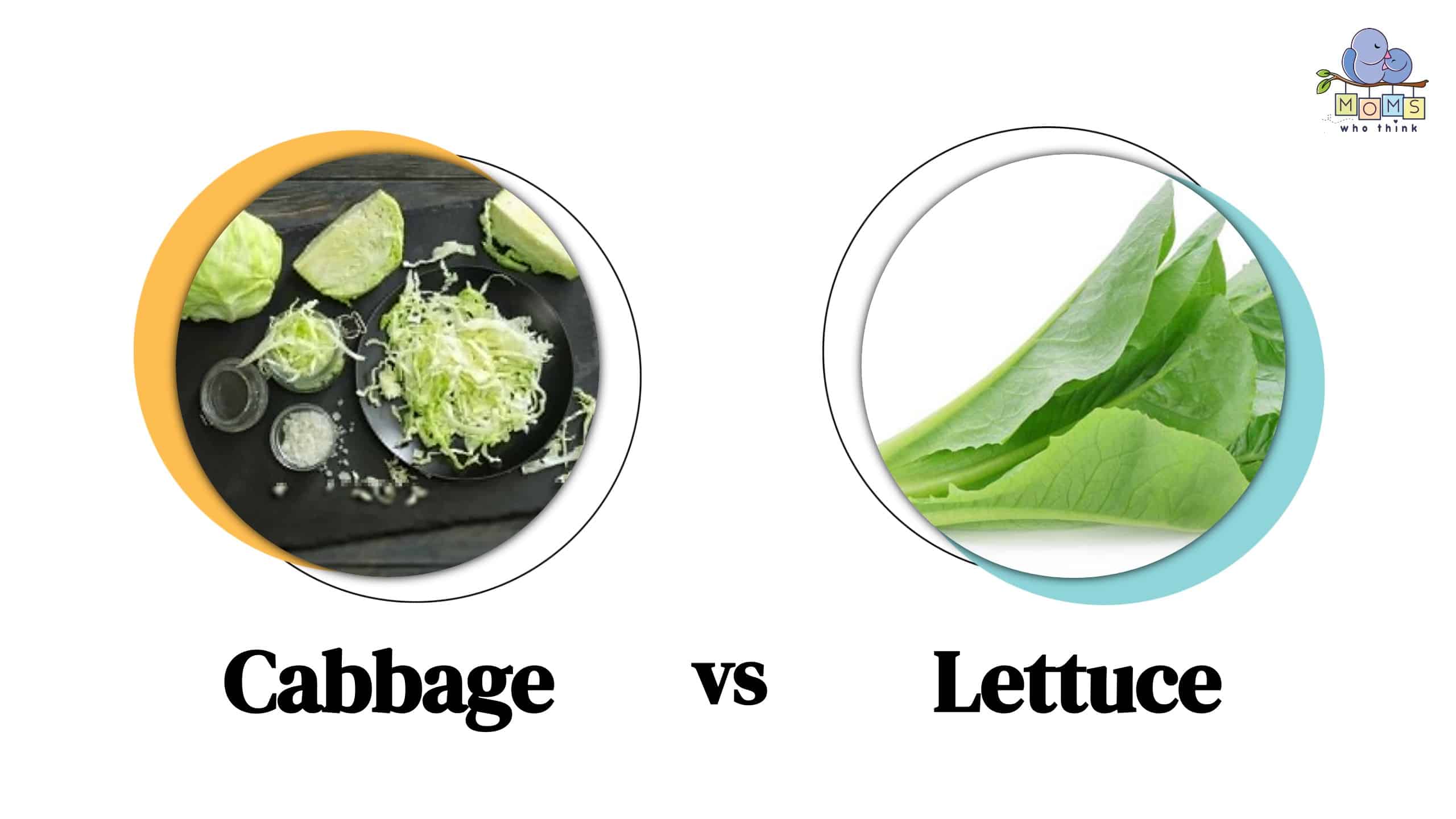When it comes to leafy green vegetables like kale, lettuce, and cabbage, it can be difficult to tell them apart. Whether you’re making a salad or looking for a side dish for a meal, you might not know which one to grab. Like other leafy vegetables, when you compare cabbage vs. lettuce, you’ll see there are some major differences between them including classification and nutritional values.
The main difference between cabbage and lettuce is their classification and flavor. Lettuce comes from the Asteraceae family while cabbage comes from the Brassicaceae family. While most types of lettuce, like iceberg lettuce, have a mild flavor, cabbage has a much stronger flavor, often described as peppery.
Cabbage and lettuce may look similar in many ways, but they’re not even in the same family of vegetables. If you’re considering the difference between cabbage and lettuce or aren’t sure which one to use in your meal, keep reading.
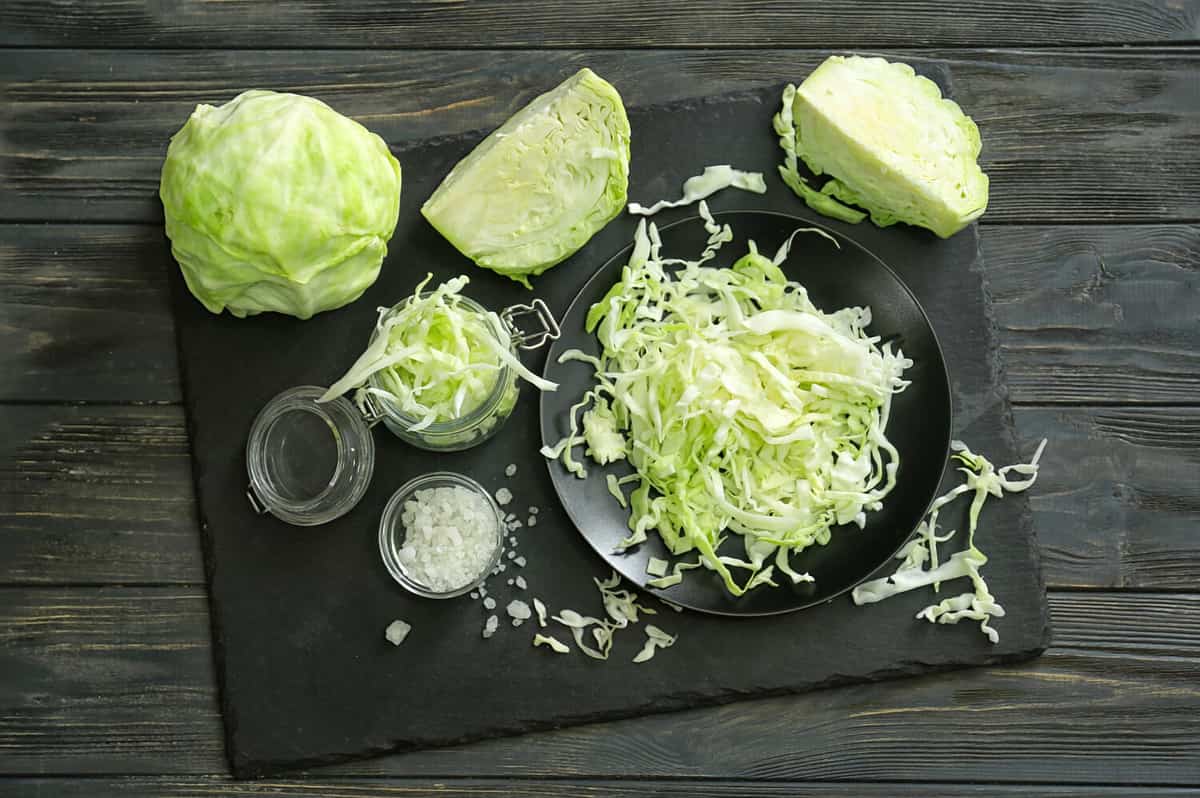
Cabbage and lettuce may look similar from the outside, but they have different flavors, textures, and nutrients.
©Pixel-Shot/Shutterstock.com
Cabbage vs Lettuce: What is the Difference?
Have you ever tried to buy lettuce at the store for a salad or burgers and realized you grabbed a head of cabbage instead? No matter what you’re using it for, it can be easy to mix up cabbage and lettuce due to their similar appearance. However, despite their similarities, when you compare cabbage vs lettuce, you’ll find quite a few differences between them.
If you have ever mixed up cabbage and lettuce, you probably noticed your mistake once you cut it open. When comparing cabbage to a type of lettuce like iceberg lettuce, the leaves of the cabbage are much tighter together. Cabbage also has a much crunchier texture.
While lettuce has a high water content and some types, like iceberg lettuce, don’t offer much flavor, cabbage has a very distinct taste. One of the most popular uses for cabbage is coleslaw because the crunchy vegetable doesn’t get as soggy as lettuce and the strong, peppery flavor pairs perfectly with the sweet, tangy dressing.
Aside from the flavor, the major difference between cabbage and lettuce is their classification. Despite their appearances, cabbage and lettuce are two completely different types of vegetables. While lettuce comes from the Asteraceae family, cabbage comes from the Brassicaceae family.
3 Main Differences Between Cabbage vs Lettuce
There are many differences between cabbage and lettuce, and they are often used for many different meals. Let’s take a look at the 3 main differences between cabbage and lettuce:
- Classification
Cabbage and lettuce are two different types of vegetables. While cabbage comes from the Brassicaceae family, lettuce comes from the Asteraceae family. Vegetables like broccoli, kale, and cauliflower fall in the same family as cabbage. Lettuce falls in the same family as chicory, artichoke, and daisies. - Taste
There are different varieties of cabbage and lettuce, which means there are some variations in their flavors. Overall, lettuce has a much milder flavor while cabbage is known for its strong bite, and the bitterness of cabbage is often described as a peppery flavor. - Texture
Lettuce leaves are much softer than cabbage leaves and due to its high water content, lettuce can get soggy pretty quickly when you cover it in dressing. Cabbage, on the other hand, has a significant crunch and can handle being used in dishes like coleslaw without becoming soggy right away.
Nutritional Values of Cabbage vs Lettuce
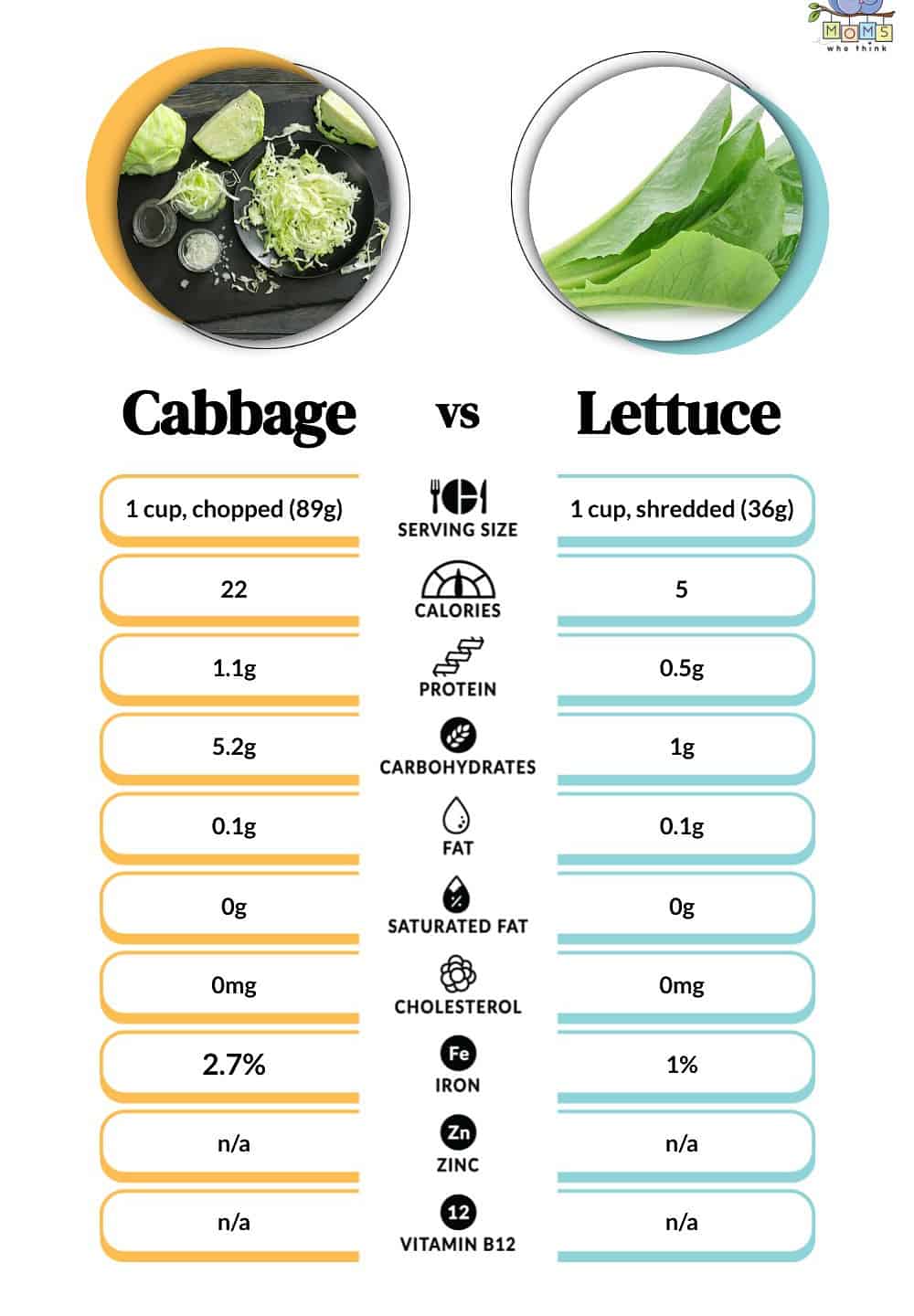
©
What is Cabbage?
Cabbage is a vegetable in the Brassicaceae family and is considered a cruciferous vegetable. Cruciferous vegetables are a part of the Brassicaceae family and other than cabbage, some other cruciferous vegetables include kale, cauliflower, and broccoli.
Like cabbage, many other cruciferous vegetables are known for their numerous health benefits. Cabbage comes in several different forms and there are different colors of cabbage such as red and purple cabbage, many having the same benefits and similar nutritional values.
Benefits of Cabbage
Even though cabbage is one of the vegetables that most people don’t think of eating on its own, it’s full of nutrients and has a lot of health benefits. Whether you include it in a salad or coleslaw or you ferment to make sauerkraut, here are some of the benefits of cabbage:
Contains Anti-cancer Properties
Like other cruciferous vegetables, cabbage has some pretty incredible anti-cancer properties. When it comes to cabbage specifically, it contains sulforaphane, which has been studied extensively as an anti-cancer agent.
Sulforaphane is a naturally occurring agent in cabbage that has been shown to target cancer cells and can prevent, block, or revert the growth of tumors. Additionally, cabbage contains antioxidants, such as anthocyanin, that have been shown to have anti-inflammatory and anti-cancer properties as well.
Improves digestive health
Another health benefit of cabbage is it can help improve your digestive health. One cup of cabbage can provide up to 4 grams of fiber. The fiber content can help you feel full for longer, which keeps you from overeating. Additionally, including enough fiber in your diet can prevent constipation.
High in Vitamin C and Vitamin K
In addition to the other health benefits of cabbage, it also is high in other vitamins such as vitamin C and vitamin K. One cup of chopped cabbage has about 32.6 mg of vitamin C and about 67.6 µg of vitamin K. Both vitamin K and vitamin C have numerous benefits for bone health, blood health, and your overall immune system.
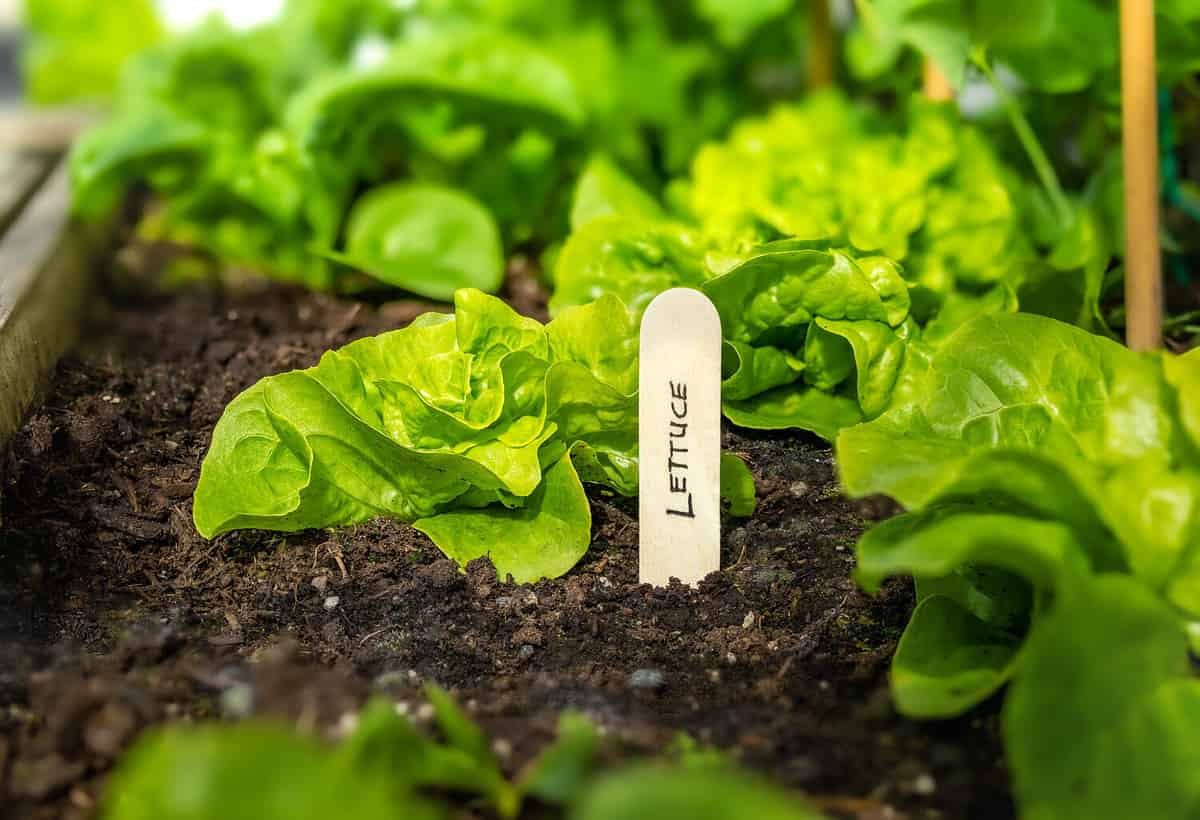
Each type of lettuce has a slightly different appearance, but the varieties of lettuce fall within four main categories.
©sophiecat/Shutterstock.com
What Is Lettuce?
Even though lettuce looks similar to cabbage, it’s part of a different vegetable family. Lettuce is classified as part of the Asteraceae family. Some of the major categories of lettuce include crisphead, romaine, butterhead, and looseleaf.
One of the most popular types of lettuce and the one that is often confused with cabbage is iceberg lettuce. Iceberg lettuce falls under the crisphead category and is often confused with cabbage because the head of lettuce and cabbage look very similar from the outside.
Benefits of Lettuce
Even though lettuce is mostly made up of water, it does have some health and nutritional benefits. It doesn’t have as many nutrients as other types of greens like kale or cabbage, but it can still be a good addition to your meals. Here are some of the benefits of lettuce:
High Water Content
All types of lettuce have high amounts of water, which can be beneficial for hydration. Different types of lettuce are about 95% water, and although it’s important to drink enough fluids, we do get a portion of our water from the food we eat, and eating lettuce can help you stay hydrated.
Small Amount of Calories
When you’re looking for a healthy vegetable but don’t want to add high amounts of calories to your meal, lettuce can be a great choice. Whether you include it in a salad or add it to a wrap or sandwich, lettuce is pretty low in calories since 1 cup of lettuce only has about 5 calories.
Vitamins A and Vitamin K
Even though lettuce is mostly made up of water, it does have some nutritional value in the form of vitamins like vitamin A and K. Lettuce can be an excellent source of vitamin A, which is helpful for skin, bone, and eye health. It’s also a good source of vitamin K, which is also necessary for bone health and proper blood clotting.
Can You Substitute Cabbage for Lettuce?
Now that we’ve discovered the differences between cabbage and lettuce, you might wonder if you can use them interchangeably. Whether you’re looking to change up the flavor of your meal or you just want to use the ingredients you have on hand, you can typically use cabbage as a substitute for lettuce.
It’s important to note that for most types of lettuce, cabbage is going to have a much stronger and more bitter flavor, so this is something to consider if you’re adding it to a sandwich or wrap. While lettuce can add a nice crunch, it doesn’t necessarily add much flavor or interfere with the flavor of your meal. If you like the flavor of cabbage, it can be great to swap lettuce out for a type of cabbage since it has more nutrients.
Cabbage vs Lettuce: Which One is Better?
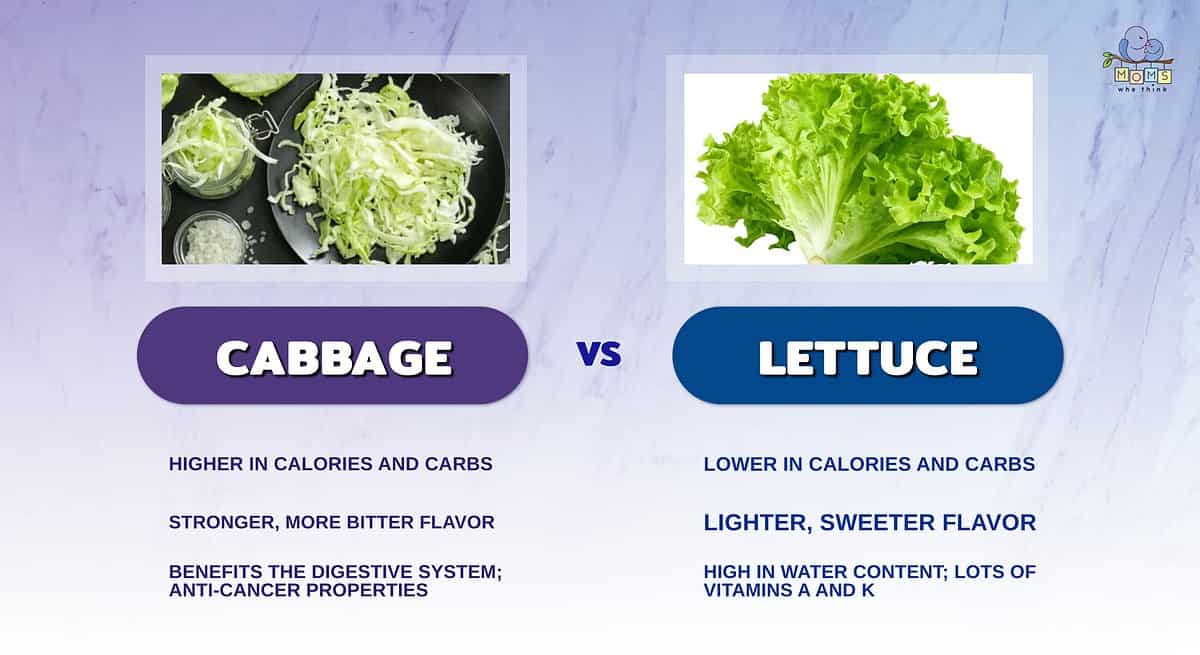
- Some people may prefer lettuce's lighter, sweeter flavor compared to cabbage's bitterness.
- Cabbage is higher in calories and carbs than lettuce, but has a number of health benefits.
- Lettuce is very high in water content; it also has lots of vitamins A and K.
Even though cabbage has more health benefits than lettuce, not everyone likes the bitter flavor of cabbage. If you’re not a fan of the cabbage flavor by itself or in a sandwich, you might try eating it in coleslaw where the dressing will counteract some of the bitterness, or even fermented as sauerkraut or kimchi.
There are enough benefits to eating cabbage that it’s worth finding a way to enjoy it. Lettuce can be beneficial in many ways as well, but since it’s 95% water, it doesn’t have as many nutrients. No matter which one you choose for your next meal, adding cabbage or lettuce to your entree can be a simple way to eat more vegetables.
Cabbage Recipes
PrintCheesy Cabbage Rice Casserole
- Total Time: 2 hours 5 minutes
Ingredients
- 1 head cabbage, shredded
- 1 cup long-cooking rice, uncooked
- 2 pounds ground beef, browned
- 28 ounce jar spaghetti sauce
- 2 cups shredded cheddar cheese
Instructions
1. Place cabbage in the bottom of a greased 13″ x 9″ baking pan.
2. Spread rice on top.
3. Pour 2 cups water over rice.
4. Spoon beef over top.
5. Pour sauce evenly over beef. Sprinkle cheddar cheese evenly over the top.
6. Bake uncovered at 375°F for 1½ to 2 hours.
7. Mix together before serving.
- Prep Time: 5 minutes
- Cook Time: 2 hours
- Potato Stuffed Cabbage
- Sauteed Cabbage
- Crock Pot Corned Beef and Cabbage
- Sausage, Potato, and Cabbage Stir-Fry
